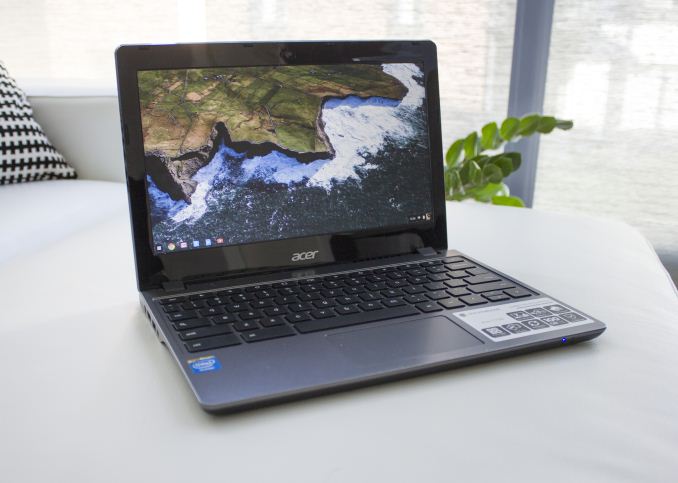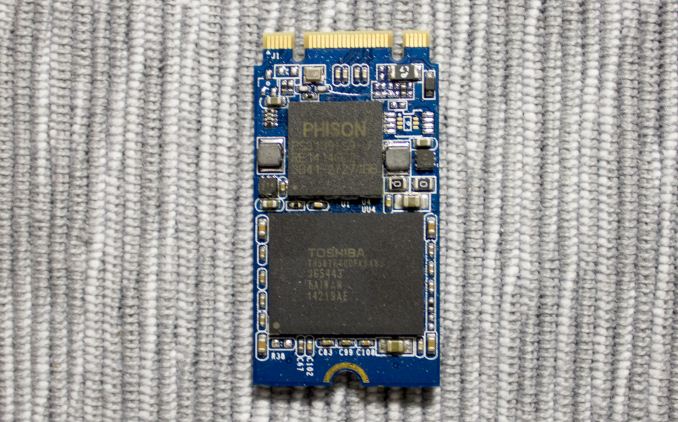Upgrading the SSD in Chromebook & MyDigitalSSD Super Boot Drive M.2 2242 SSD Review
by Kristian Vättö on October 21, 2014 8:00 AM EST
While the whole netbook boom kind of died with the introduction of tablets, Chromebooks have been gaining more and more traction recently. The original Windows netbooks failed to provide a smooth user experience due to the lack of operating system optimization, and Windows was simply way too heavy to be run with such limited resources. Chrome OS on the other hand was designed specifically for netbook-like devices. Google took a totally different approach by designing the Chrome OS around web and cloud-based services, which allowed the OS to be run with very little onboard storage.
Most of today's Chromebooks actually ship with either a small mSATA/M.2 SSD or have an eMMC package onboard, which is a bit ironic since Chromebooks are generally the cheapest laptops around, yet if you buy a Windows laptop that costs twice as much you will most likely end up with a traditional hard drive for storage. That is an enormous benefit that Chromebooks have because the lack of a hard drive enables much thinner and lighter designs, which translates into a better user experience.
The majority of the Chromebooks have 16GB of onboard storage with some high-end models having twice that. For the intended usage where everything is done in the web, that is sufficient, but when you need local storage for offline occasions (e.g. when traveling), 16GB or 32GB will not get you far. There is always the option of carrying external storage to expand the internal storage, but there is another alternative: upgrading the internal SSD.
For the purpose of this review, MyDigitalSSD sent us a 256GB Super Boot Drive in M.2 2242 form factor along with Acer's C720-2848 Chromebook.
| Acer C720-2848 Chromebook Specifications | |||||||||
| Display | 11.6" 1366x768 | ||||||||
| Processor | Intel Celeron 2955U (2/2, 1.4GHz, 2MB, 15W) | ||||||||
| Graphics | Intel HD Graphics (200MHz, 1GHz max Turbo) | ||||||||
| Memory | 2GB DDR3 | ||||||||
| Storage | 16GB SSD (M.2 2242) | ||||||||
| Connectivity | WiFi (802.11 a/b/g/n), Bluetooth 4.0, 1x USB 3.0, 1x USB 2.0, SD card reader, 1x HDMI | ||||||||
| Dimensions | 11.34" x 8.03" x 0.78" (W x D x H) | ||||||||
| Weight | 2.98lb | ||||||||
The C720 is what you would expect a Chromebook to be. The display is a bad TN panel, the trackpad does not always feel responsive, and the overall build is just plastic. It feels cheap, but the positive thing is that it really is cheap, as the C720-2848 currently retails for just $200. I cannot really give an objective review of the laptop itself as I have not used any other Chromebooks, but overall I am fairly impressed with what $200 gets you nowadays.
| MyDigitalSSD Super Boot Drive M.2 2242 Specifications | |||||||||
| Capacity | 8GB | 16GB | 32GB | 64GB | 128GB | 256GB | |||
| Controller | Phison S9 (PS3109) | ||||||||
| NAND | Toshiba A19nm MLC | ||||||||
| Sequential Read | Up to 545MB/s | ||||||||
| Sequential Write | Up to 410MB/s | ||||||||
| Warranty | Three years | ||||||||
Like other MyDigitalSSD's SSDs, the Super Boot Drive is based on a Phison controller and comes in a variety of capacities. The M.2 2242 currently tops out at 256GB since the form factor limits the number of NAND packages to two, and with 16GB die 128GB packages are the biggest that are available in the open market.
Notice that there is no DRAM at all. The M.2 2242 form factor lacks the space for a dedicated DRAM chip, so the NAND mapping table and host IO caching is done in the internal caches of the controller (usually a few megabytes of SRAM). There is a bit of a performance penalty from doing that as the internal caches are much smaller, but it is the only viable way to squeeze a full SSD into such small area.
Test Systems
There are two major items we want to look at in this review: first, we want to investigate the upgrade procedure for the Acer C720 Chromebook and examine Chrome OS performance, and second we're going to look at the MyDigitalSSD Super Boot Drive as a standard SSD and run our usual storage tests. For AnandTech Storage Benches, performance consistency, random and sequential performance, performance vs. transfer size and load power consumption we use the following system:
| CPU | Intel Core i5-2500K running at 3.3GHz (Turbo & EIST enabled) |
| Motherboard | ASRock Z68 Pro3 |
| Chipset | Intel Z68 |
| Chipset Drivers | Intel 9.1.1.1015 + Intel RST 10.2 |
| Memory | G.Skill RipjawsX DDR3-1600 4 x 8GB (9-9-9-24) |
| Video Card | Palit GeForce GTX 770 JetStream 2GB GDDR5 (1150MHz core clock; 3505MHz GDDR5 effective) |
| Video Drivers | NVIDIA GeForce 332.21 WHQL |
| Desktop Resolution | 1920 x 1080 |
| OS | Windows 7 x64 |
Thanks to G.Skill for the RipjawsX 32GB DDR3 DRAM kit
For slumber power testing we used a different system:
| CPU | Intel Core i7-4770K running at 3.3GHz (Turbo & EIST enabled, C-states disabled) |
| Motherboard | ASUS Z87 Deluxe (BIOS 1707) |
| Chipset | Intel Z87 |
| Chipset Drivers | Intel 9.4.0.1026 + Intel RST 12.9 |
| Memory | Corsair Vengeance DDR3-1866 2x8GB (9-10-9-27 2T) |
| Graphics | Intel HD Graphics 4600 |
| Graphics Drivers | 15.33.8.64.3345 |
| Desktop Resolution | 1920 x 1080 |
| OS | Windows 7 x64 |
- Thanks to Intel for the Core i7-4770K CPU
- Thanks to ASUS for the Z87 Deluxe motherboard
- Thanks to Corsair for the Vengeance 16GB DDR3-1866 DRAM kit, RM750 power supply, Hydro H60 CPU cooler and Carbide 330R case












67 Comments
View All Comments
pSupaNova - Wednesday, October 22, 2014 - link
No he is correct, Microsoft did not want netbooks to succeed.While Intel tried to Gimp their graphics and even stopped Nvidia ION project from improving the graphics situation
This mistake let tablets have an easier ride and now Nvidia has a remarkable SOC in the K1 thats going to eat Intel alive in the coming years.
jabber - Wednesday, October 22, 2014 - link
Netbooks were awful. They deserved to die. I ended up refusing to fix or work on them for customers. They would bring them to me saying "this is slow!" I would reply "It's because it IS slow!"Poor user experience and a waste of money. A novelty that should never have survived longer than a few months.
mike8675309 - Tuesday, October 21, 2014 - link
There were two specific problems. #1 - slow hard drives. #2 - no hardware video acceleration. With the Atom chip and slow drives with no hardware video acceleration, you have what is sitting in my basement and is effectively useless.hojnikb - Tuesday, October 21, 2014 - link
And its pretty much possible to make one for 150-200$, since windows licenses are free with cheap devices and Intel tablet SoC are selling for peanuts.Eeebook x205 is an example of that.
inmytaxi@gmail.com - Sunday, November 2, 2014 - link
The 10 inch laptop form factor is dead for windows, replaced by 10 - 11.6 inch tablets many with removable or flip-able keyboards.sligett - Tuesday, October 21, 2014 - link
All my users of HP 3105m netbooks (with AMD e-350 processors, and SSD or HDD) chose to move to Chromebooks when they were offered to them. In the schools where I work, a Windows laptop would have to be LESS expensive than a Chromebook to be attractive. In fact, a $200 Chromebook is in many ways more appealing than a free Windows laptop.RU482 - Tuesday, October 21, 2014 - link
My 12yr old daughter would object to your statement about AMD Brazos. I'll agree, when I bought the Lenovo Netbook that had the E-350 CPU for my traveling notebook/netbook, it was miles ahead of the Atom Z520 based Asus netbook that it replaced.Fast forward to 2014, the Lenovo has been handed down to my daughter, who likes to watch Netflix or play flash games on it. She's recently started to complain about how laggy the Lenovo has become. SSD health and free space are still good, wifi signal strength 5 bars....not sure what the excuse is, maybe she's used mom's i5 Haswell laptop too much! I'd say it's time to retire the Lenovo Brazos machine
Michael Bay - Wednesday, October 22, 2014 - link
In any netbook article one can expect a couple of sad AMD fanatics with drivel like that.Wake up, Brazos was hot as all hell and didn`t deliver anything Atom couldn`t.
waldojim42 - Thursday, October 23, 2014 - link
Yes, they most certainly did. Video acceleration and useful CPU performance. AMD made netbook CPU's that had significantly higher IPC at a cost of higher power usage.savagemike - Tuesday, October 21, 2014 - link
It's pretty easy to dual or co-boot linux on a Chromebook, and honestly that would be about the only good reason to upgrade storage to this kind of capacity. It would, of course, provide a whole host of tools/programs which would address some of the drawbacks you mention.That makes sense as desktop Linux, like Windows or OSX, are designed for a traditional local storage centric paradigm, where the ChromeOS devices of course are not.
The one true fault of the ChromeOS file explorer within its own context is the lack of local network integration. You really should be able to see/use shares on a LAN from the files app on a ChromeOS device and you can't.